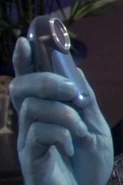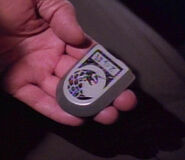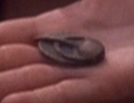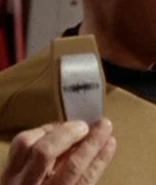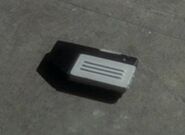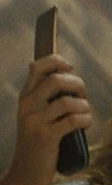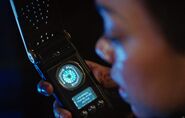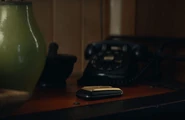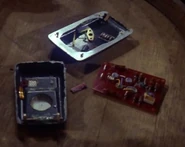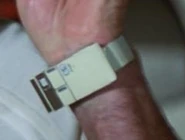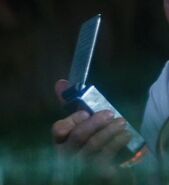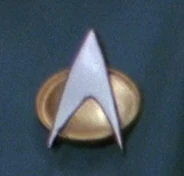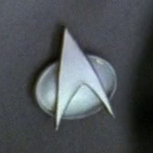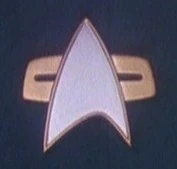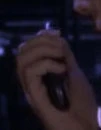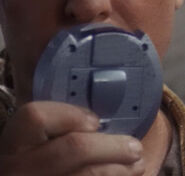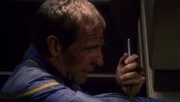
Captain Jonathan Archer handling a style of communicator used in the 2150s
A communicator was a communications device used by many species for person-to-person, inter-ship communications. A communicator could be either an intercom or a hand-held personal receiver that could be used for person-to-ship comunications. (TOS: "The Conscience of the King", "Journey to Babel") Communicators usually transmitted on subspace frequencies. They were eventually integrated into and replaced by combadges.
Specifications[]
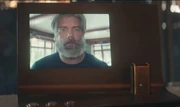
Starfleet clamshell communicators could link up with certain devices equipped with viewscreens.
Portable communicators were used by Starfleet landing parties and away teams; occasionally, communicators were used in situations where normal intra-ship communications were inaccessible (or inadvisable), during the 22nd and 23rd centuries. (TOS: "Mirror, Mirror", et al.)
Employing a flip-top design, a member of Starfleet spoke directly into the device to give commands and speak with other personnel. (TOS: "The Cage", et al.) Once it was flipped open, it locked onto the originating ship's communications system. (TOS: "A Piece of the Action") The communicator also had a gain control. (TOS: "Shore Leave")
In the alternate reality, Starfleet communicators could also receive text messages. (Star Trek Into Darkness)
In some cases, communicators served purposes beyond basic communication. By 2152, for instance, the power signature of a Starfleet communicator could be amplified by an inverse carrier wave, making the communicator detectable by sensors. (ENT: "The Communicator") For another example, when accessing a computer, the communicator of the person at the terminal logged in the user information, thereby making it possible to trace back who accessed the computer. (TNG: "The Drumhead") Communicators were also often used to allow transporter locks for beaming, thus acting as homing transponders. When used in tandem, two communicators could produce a sonic disruption by using sound beams to create a sympathetic vibration in an unstable object, such as a cliff face. (TOS: "Friday's Child") Usage of a communicator, while receiving and outputting a signal, could be hidden from sensors by triaxilating the signal. (ENT: "Detained") Communicators could be jammed by a security screen, the like of which was employed at the Tantalus Colony. When the screen was deactivated, the communicator signal was enabled. (TOS: "Dagger of the Mind")
By the 24th century, these communication devices were integrated into the standard uniform badges and became known as combadges. Users no longer had to speak directly into the communicator, but rather could activate and deactivate them with the touch of a finger. (TNG: "Encounter at Farpoint", "Yesterday's Enterprise", et al.)
By the 32nd century, the technology for the communicator had been miniaturized to the point where it could be included with other functions in the tricom badge. Activation and deactivation of the communicator was by hand gestures. (DIS: "Scavengers")
Other species also possessed similar communicator devices. (TOS: "A Taste of Armageddon", "Errand of Mercy", "Elaan of Troyius"; ENT: "Fallen Hero", "Marauders", "Precious Cargo", "The Catwalk", "Extinction", "Rajiin", "Chosen Realm", "Proving Ground", "Storm Front", "Storm Front, Part II", "Borderland", "United", "Affliction", "Bound", "Terra Prime"; Star Trek Beyond) An Enolian communicator, for instance, could double as a remote control for handcuffs. (ENT: "Canamar")
In the final draft script of "Precious Cargo", a Retellian communicator was referred to simply as "a hand-held device" without the name "communicator" being referenced.
In the final draft script of "Terra Prime", an Andorian communicator was referred to as being "spanned shut" in one scene, though the final configuration of the device evidently wouldn't have allowed this, as it wasn't a type of communicator which opened and closed.
History[]
The Vulcans had communicators as early as 1957. Some of these early Vulcan communicators were among equipment owned by the crew of a Vulcan survey ship. After the vessel crash landed on Earth, the surviving members of the crew secretly used the Vulcan communicators in Carbon Creek, Pennsylvania, a nearby small mining town in the United States of America. (ENT: "Carbon Creek")
While the Andorian commander Thy'lek Shran was holding personnel from the NX-class starship Enterprise NX-01 hostage in June 2151, Captain Jonathan Archer's communicator was, after being used by Shran to threaten Enterprise, crushed by him, using the Stone of J'Kah to smash the device to pieces. The destruction of the communicator caused Enterprise to lose the signal connecting them. The ship then tried to make contact with Sub-commander T'Pol and Commander Trip Tucker, the only other crew members from Enterprise who were being held captive along with Archer. However, their communicators were likewise immediately crushed by Shran. (ENT: "The Andorian Incident")
When Captain Archer and Ensign Travis Mayweather were enduring imprisonment at Tandaran Detention Complex 26 in about late 2151, a communicator was secretly beamed into their cell from Enterprise. The device's usage was masked, due to Enterprise Communications Officer Hoshi Sato triaxilating the signal between the communicator and the ship, though the Tandaran guards subsequently discovered the device in Mayweather's pocket. The Tandarans confiscated the communicator, and because both Mayweather and Archer were resistant to questioning about where they had obtained the device, they were brutalized by the Tandarans. (ENT: "Detained")
In 2152, fears among the Enterprise crew arose regarding how a communicator that Lieutenant Malcolm Reed had accidentally left behind on an inhabited planet might affect the evolution of a pre-warp culture on that planet. In an effort to find the device, the communicator's power signature was boosted by Enterprise. The communicator was finally retrieved, but not without avoiding cultural contamination partly caused by the device. (ENT: "The Communicator")
In the final draft script of ENT: "Carpenter Street", a final usage of a communicator by Archer, contacting Reed while both were on Enterprise, was scripted to instead be a usage of a companel.
Kirk and Spock used the communicators' technique of producing sympathetic vibrations in a cliff face to ward off a party of angry Capellans on Capella IV in 2267. (TOS: "Friday's Child")
In 2267, Alice 99 crushed, with her bare right hand, a communicator Kirk had been holding. Her action prevented him from contacting his ship, the USS Enterprise. (TOS: "I, Mudd")
In Starfleet, the flip-top communicators were essentially replaced by 2344, when combadges instead came into general use. (TNG: "Yesterday's Enterprise")
In 3189, the 23rd century communicators of the USS Discovery crew were replaced by the tricom badges. (DIS: "Scavengers")
Limitations[]
Communicators were susceptible to changes in temperature. In 2266, Hikaru Sulu believed the cold conditions on Alfa 177 were affecting his communicator. (TOS: "The Enemy Within")
Gallery of communicator styles[]
Appendices[]
Background information[]
Origins[]
The communicator has shared roots with the universal translator. The "telecommunicator", the genesis of both these technologies, was originally proposed in the series outline Star Trek is... and additionally appeared in the story outline for "The Cage" (both of which are reprinted in The Making of Star Trek). Although the device was planned to be used for translating all languages into English, the initial draft of Star Trek is... also described the telecommunicator as "little more complicated than a small transistor radio carried in a pocket," matching a description of Spock's communicator from the script of "The Cage" as "transistor radio-size." Furthermore, the story outline for "The Cage" regarded the telecommunicator as having some of the later-established capabilities of communicators, such as producing "a maximum radio signal" – which is of insufficient strength to completely cut through "a half-mile of solid balsite rock," but allows a bearing to be obtained (much like how later communicators enabled transporter locks). Communicators aboard the Enterprise were also once mentioned in the story outline, though their specifics weren't made clear. (The Making of Star Trek, pp. 52 & 60)
According to the book The Making of Star Trek: The Motion Picture (p. 147), Gene Roddenberry knew – at the time Star Trek's first communicators were designed – that they were too large to be realistic for the future setting of the series, since miniaturization was common at the time and micro-miniaturization was certainly foreseeable for the near future. Since this was not a reality in those days, however, Roddenberry believed the general public would have a better comprehension of communicators that could be more easily seen.
The original look of the communicator, as featured in "The Cage", was designed by Wah Chang. (The Art of Star Trek, p. 13) Dave Rossi commented, "Inside, all you see are these transistors, but the top of the communicator is very reminiscent of the Captain Kirk style communicator. So, they kept some of that and refined it." Rossi also described a close-up view showing one of the early communicators as "a great shot." ("The Menagerie, Part II" Starfleet Access, TOS Season 1 Blu-ray) A communicator prop from "The Cage" was subsequently modified to become the neural stimulator's remote control from TOS: "Spock's Brain". (The Art of Star Trek, p. 13)
Wah Chang additionally created the first working model of communicator for the regular episodes of Star Trek: The Original Series. To achieve the spinning moire effect of this style of communicator in operation, Chang positioned a clear moire transparency atop another moire pattern, the latter of which was powered by a wind-up stopwatch (no batteries). Chang constructed two operational models and eight "dummy" communicators. (Cinefantastique, Vol. 27, No. 11/12, p. 79) He charged Desilu a mere US$1,019.20 for designing and producing these props. (Star Trek: The Original Series Sketchbook, p. 239)
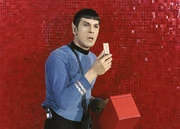
A deleted scene from TOS: "Operation -- Annihilate!" featuring a communicator being used by Spock
The sound produced by the TOS style of communicator was a part of the device's success, as Ben Burtt, who designed the sound effects for 2009's Star Trek, explained; "The fact that the communicator made a cute little chirping sound, as if it were a little animal talking to you, made it all the more interesting and it sold the idea to the audience that it's really a piece of functioning technology." (Ben Burtt and the Sounds of Star Trek, Star Trek BD) The communicator's sound effects were redone by sound editor Douglas Grindstaff in the second season of TOS. (Cinefantastique, Vol. 27, No. 11/12, p. 85)
As written in the final draft script of "Arena", the Metron communicator that the Metrons provide to Kirk in that episode was to have instead been from his own possession. The script referred to this type of tool as a "transicator device" that was electronic in nature (as well as using more generic terms for it, such as a "translator-recorder" and a "communicator device"), and described the device as "a small box, with dials and gauges." In common with the Metron communicators of the final episode, these devices were to have been carried in their respective user's belt, when not in use.
Developments for Phase II and early films[]
The communicator was planned to be slightly revised for the ultimately abandoned series Star Trek: Phase II. In a memo dated 19 July 1977, producer Robert Goodwin proposed that the device still be a "hand communicator," but updated with several new functions. One of these suggested capabilities was essentially as a conduit of information between a generic tricorder and the Enterprise's computer banks, enabling landing parties to remotely utilize the ship's profuse analytical equipment. (Star Trek Phase II: The Lost Series, pp. 29 & 30) Both the idea that the communicator remain as a portable hand tool and its capacity to be operated in conjunction with a tricorder – so that the communicator could transmit information directly into the Enterprise computer banks – were adopted into the series' writers/directors guide. (Star Trek Phase II: The Lost Series, p. 96)
With miniaturization in vogue in the 1970s (by which point communicators had shrunk to the size of credit cards), it was readily apparent that the new communicators could not continue to be as large as they had been in the original series. Gene Roddenberry had various ideas for how to miniaturize the devices. One concept was having them become implants, though someone noted it would look funny to see one of the 23rd century people talking to one of their own elbows. (The Making of Star Trek: The Motion Picture, p. 147) The invention of the wrist communicator was made either shortly before or during the writing of the first-draft script for "In Thy Image" (which was conceived as the pilot episode of Phase II but gradually developed into Star Trek: The Motion Picture); that script includes not only a wrist communicator that was said to be flipped open and manually closed but also a hand communicator which was referred to as being "old-style." (Star Trek Phase II: The Lost Series, pp. 126 & 218) Wrist communicators were included in Phase II on the condition that they looked completely different from ones that Dick Tracy had been using for decades, in comics. Thus, it was decided to keep all the workings of the new communicator on the inside of the wrist, varying from the Dick Tracy device. (The Making of Star Trek: The Motion Picture, p. 147)
The design for the wrist communicators of The Motion Picture was created by Andrew Probert. (The Art of Star Trek, p. 182) According to the book The Making of Star Trek: The Motion Picture (p. 147), the film's wrist communicators could be used to directly contact the Enterprise's main computer, a capacity that is not shown in the movie. These communicators were built by Brick Price Movie Miniatures, to be worn not only by the principal actors but also by dozens of fans who served as extras in a crowded scene on the Enterprise's recreation deck. (Enterprise Incidents #11, p. 5; Star Trek Phase II: The Lost Series, p. 230) Each of the units built for the main characters had four different-colored functioning lights on the faceplate, but these were not built into the props worn by the extras. (Star Trek: The Magazine Volume 2, Issue 8, p. 101) Indeed, the units fitting the latter style were only "Cheap $1.98 Specials." (Enterprise Incidents #11, p. 5) The reasoning for these much flimsier and less expensive copies was to avoid overspending the prop budget, since it was inevitable that some of the fan-exclusive props would be lost to seekers of souvenirs. (Star Trek Phase II: The Lost Series, p. 230) The prototype of the wrist communicator cost US$3,500, was battery-operated so it could light up and was used for "insert", close-up shots. (The Making of Star Trek: The Motion Picture, p. 147) 250 communicator props were built, though most of these were the dummy communicators used by extras; only ten units had functioning lights. (Star Trek: The Magazine Volume 2, Issue 8, p. 101) The first time William Shatner used his wrist communicator, he wore the prop backward. Luckily, property master Dick Rubin was on the set at the time and explained the prop to Shatner. (The Making of Star Trek: The Motion Picture, pp. 144 & 145)
The wrist communicator was replaced by an updating of the TOS design for Star Trek II: The Wrath of Khan. (The Art of Star Trek, p. 204) "It's an understandable decision," commented Michael Okuda, regarding the choice to return to the flip-top style. "You want to do something that's more advanced, and then after you've done it, you realize, 'Oh – we've lost one of our icons.'" (audio commentary, Star Trek: The Motion Picture (Blu-ray)) The communicators in Star Trek II were overseen by prop master Joe Longo. (text commentary, Star Trek II: The Wrath of Khan (The Director's Edition) DVD) These were essentially recycled Vietnam War walkie-talkie units, stripped of paint and coated with chrome. "It was what Paramount wanted," stated John Zabrucky, whose Modern Props facility created the communicators. "We had a really great design that we wanted to build, but they were fixed on those things." (The Making of the Trek Films, 3rd ed., p. 29) TOS era Star Trek films produced after Star Trek II have remained with the flip-top design aspect.
For Star Trek III: The Search for Spock, there was some initial discussion about the possibility of replacing the standard Starfleet communicators with watch-televisions that were available from companies such as Sony Corp. of America. "But it proved too expensive," concluded associate producer Ralph Winter. (The Making of the Trek Films, 3rd ed., p. 53) The Starfleet communicator that was ultimately developed for Star Trek III was essentially a sleeker version of the TOS communicator and was designed by Bill George of Industrial Light & Magic. (text commentary, Star Trek III: The Search for Spock (Special Edition) DVD) The Klingon communicator of the same film was also designed by ILM. (The Art of Star Trek, p. 218) The prop for the Klingon variant had a small round feature that, although clearly intended to resemble a tiny microphone, was actually the cutting head of a rotary electric razor. (text commentary, Star Trek III: The Search for Spock (Special Edition) DVD)
The prop for the Starfleet communicator from Star Trek III was revamped for use in Star Trek V: The Final Frontier, wherein it was modified to include a large light that could illuminate the communicator grill as well as the face of the actor handling the prop. [1](X) These communicators were one style of numerous props for Starfleet equipment that, during filming of Star Trek V (or at least amid the shooting of the film's interior bar scenes on Nimbus III), were supervised by prop masters Don and Kurt Hulett, who kept track of the incoming and outgoing props. (Captain's Log: William Shatner's Personal Account of the Making of Star Trek V: The Final Frontier, p. 154)
TNG redesigns[]
The Starfleet communicator underwent more changes, in conversion between the original Star Trek series and Star Trek: The Next Generation, than either the tricorder or phaser. The design team of TNG initially returned to the idea of wrist communicators and Rick Sternbach drew a number of concept illustrations like that, several of which included a digital watch area. A similar concept (labeled an "Archer" Com) was a metallic gray device that covered much of the back of the wearer's hand and was attached around both the wrist and middle finger. (Star Trek: The Next Generation - The Continuing Mission, p. 39) The first two writers' bibles for TNG outlined the communicator as being of the wrist design. (Star Trek: The Next Generation Companion, 3rd ed., p. 11) Props master Alan Sims commented, "The earliest idea in TNG was to drop the wrist communicator [...] because it just didn't work for television." (Star Trek: Aliens & Artifacts, p. 98)
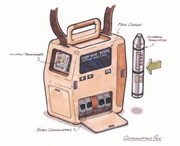
Concept artwork for a "communications pack"
Next, the producers of TNG considered that the characters of the upcoming series wear an unusually large-scale model of communicator. "They said that they should hang a communicator right on the uniform just like the police wear today," reflected Alan Sims. (Star Trek: Aliens & Artifacts, p. 98) In accordance with this request, Sternbach created a concept drawing of a large-scale "communications pack", which was intended to contain multiple wrist communicators. (Star Trek: The Next Generation - The Continuing Mission, p. 40) "That turned out to be too big and not futuristic-looking," said Alan Sims. "You could see police on the street with shoulder communicators so why should that remain the same for three centuries? They went round and round with the communicator." (Star Trek: Aliens & Artifacts, p. 98) Sternbach recalled, "At one early production meeting in 1987, we discussed many possible communicator designs, mostly handheld widgets with Starfleet emblems." Gene Roddenberry looked at these and, moments later, suggested the conceptual breakthrough of combining the communicator with the Starfleet insignia as a badge. (Star Trek: The Magazine Volume 2, Issue 12, p. 45)
When John Eaves was assigned the task of updating the communicator for Star Trek Generations, he – never having seen an episode of TNG but being a loyal fan of the original series – at first mistakenly based the look of the revised configuration on the flip-top communicator of TOS, before he found out that the device's appearance had developed since then. (Star Trek: The Next Generation Sketchbook: The Movies, p. 34)
Retro designs[]
For DS9: "Trials and Tribble-ations", Star Trek fan Steve Horch produced re-creations of TOS-era communicator props. At least three such replicas were built by him. (Cinefantastique, Vol. 29, Nos. 6/7, p. 77; [2](X)) During the episode's production, Miles O'Brien actor Colm Meaney had some difficulty with opening his TOS-style communicator prop. "It kept flipping open and then bouncing closed," recalled Walter Koenig, who was on the set at the time. He asked Meaney for the prop, planning to open it for him and hoping that it would stay open thereafter. "I took it from him," continued Koenig, "and I flipped it open and it stayed open." (Cinefantastique, Vol. 29, Nos. 6/7, p. 81)
The same organization was also responsible for creating the communicators of Star Trek: Enterprise. [3](X) Owing to the setting of Enterprise being around a century earlier than that of TOS, regular usage of flip-top communicators was reintroduced on the later-produced series. (text commentary, Star Trek II: The Wrath of Khan (The Director's Edition) DVD) As nobody wanted the communicators of ENT to be clunkier than a modern cell phone, however, the newly created devices were designed to be more streamlined than their equivalents from TOS. ("Broken Bow" text commentary, ENT Season 1 DVD) Explained executive producer Rick Berman, "The communicators of Captain Kirk [...] a hundred years later, were more clumsy than a cell phone is today. So, we had to, sort of, split the difference." ("Broken Bow" audio commentary, ENT Season 1 DVD) Property master Craig Binkley related, "Rick and Brannon [Braga] wanted [the new style of communicator] to flip up, but they wanted it to be very modernistic." (Star Trek: Communicator issue 138, p. 36)
The hand-held ENT communicators were Craig Binkley's responsibility and were designed by illustrator Jim Martin. ("Broken Bow" text commentary, ENT Season 1 DVD) Once Binkley had questioned Rick Berman and Brannon Braga about how they thought the new retro communicators should look different from contemporary cell phones, Martin and Binkley began to conceive of the workings of the futuristic communicators. Binkley recalled, "There were a lot of concept ideas: Jim would do a lot of illustrations, I'd throw my two cents in, and Rick and Brannon would zero in on what they'd like – 'Well, I like this part of the communicator in this sketch, I don't like that.'" (Star Trek: Communicator issue 138, p. 36) Jim Martin's work on the updating of the communicator impressed John Eaves, who remarked, "I so loved [...] the work he did with the reworking of the communicator and translator props." [4]
The series' art department supplied drawings of the communicators to HMS Creative Productions, Inc. These illustrations had been repeatedly revised, many times, before Michael Moore – a member of the latter team, who created the Starfleet communicators – viewed them. Besides some "hero" props (specifically, numerous working models as well as a range of rubber ones), several wax communicators were additionally built, early in the series. These were made to break apart easily, to portray Shran smashing them to pieces in "The Andorian Incident". All of the hero communicators had spring-loaded self-opening antenna grids, and each of the working ones had a light-up graphic. The display was drawn by Robert Mannion, inspired by on-screen graphics from colleague Steve Horch's Motorola Timeport cellphone. [5](X) [6]
In one scene from ENT: "Sleeping Dogs", the episode's final draft script described a Starfleet landing party as using, for ship-to-ship communication, the "suit coms" built into their EV suits, while wearing the lower parts of the suits but not their helmets. However, one of the hand-held communicators are instead used in the final version of that scene.
Although one particular writer who was hired onto ENT Season 2 by Brannon Braga tried to fake a foreknowledge of Star Trek, a description which the person gave about communicators made it clear they had lied. "[It] was so wrong. It was... they put it up to their ear, you know, like a phone or something like that," Brannon Braga recalled, laughing. ("Part One: Call to Arms", ENT Season 3 Blu-ray special features)
The design of the alternate reality communicator, which debuted in the 2009 film Star Trek, was impacted by the fact that – although the TOS-era communicator had elements that seemed futuristic when the device was initially designed – those same elements had become outdated by the time the film was in pre-production. Prop master Russell Bobbitt recalled, "I connected with Nokia, their engineers and we asked ourselves, 'What will it be 400 years in the future?' We did some conceptual drawings." [7] In fact, at least seven different communicator designs were sketched for the film, before the final one was selected. "We kept bits from the original, like the lid that flips up," commented Bobbitt. Although many of the potential designs proposed the inclusion of a glass sphere that would provide a holographic display, this element did not make it into the final design. (Star Trek - The Art of the Film, p. 108) Bobbitt and his team went on to build a prototype model that cost US$50,000. [8] The Star Trek crew also made a communicator prop for scenes set aboard the USS Kelvin in 2233. The Kelvin-era communicator had an orange flip-top branded with the ship's assignment patch, and a bronze interior resembling its prime reality successors. [9]
Props Master Andrew Siegel, who was assigned to work on Star Trek Into Darkness, considered it fortunate that the previous Star Trek movie had redesigned the communicator. As such, this reduced the amount of work that the props department for the new film had to do to update the device. During production on Star Trek Into Darkness, though, the communicator props did not escape the danger of breakage. "There was a dicey moment with a communicator where an actor chose to use it in a way that definitely endangered its longevity," remembered Siegel. "I sweated on that one a little bit, but it all worked out. It actually looks great in the finished scene." (Star Trek Magazine issue 173, pp. 78 & 80)
As regards the design of Starfleet communicator in Star Trek: Discovery, Aaron Harberts described communicators as "super-important [...] key props" that "nobody wanted to really change." [10]
Cultural impact[]
The way in which both the TOS-era communicator and its TNG equivalent were operated became pop culture icons, as noted by Alan Sims; "The single chest tap became the signature motion of TNG the way the wrist flip became the signature motion of the original series." (Star Trek: Aliens & Artifacts, p. 98)
The Star Trek Encyclopedia, 3rd ed., p. 518 notes that, when the communicator was first invented in 1964, it appeared to be incredibly advanced and compact, with few believing that Star Trek would still be airing when portable cellular phones were invented. Dr. Martin Cooper, the inventor of the modern mobile phone, credits the TOS communicator as being his inspiration for coming up with the invention in the 1970s (when he was a General Manager of Systems at Motorola). [11] Stated André Bormanis, "Some engineer at Motorola thought, 'Hey it’d be cool to make this look like the communicator, but we need to make it smaller. Or fold it. You can flip it open like Kirk and Spock did, because that was so cool.'" (The Fifty-Year Mission: The Next 25 Years, p. 32) An exhibit that encompassed information on how the portable phone originated from Star Trek was included in Star Trek: The Exhibition when it moved to London in October 1995. (Star Trek Monthly issue 9, p. 6) An actual TOS-era communicator was also included in the exhibition but was a part of the touring collection from its beginnings in Edinburgh. (Star Trek Monthly issue 1, p. 20)
Since the 1970s, the influence of the communicator on the mobile phone has continued to become increasingly apparent. For instance, in a 1996 interview, Robert Picardo – actor of The Doctor – commented, "The Motorola flip-phone is simply a communicator turned upside down." (Star Trek Monthly issue 18, p. 55) In an interview from later that year, Rick Sternbach concurred, "We've done a number of interviews where the typical comparison is made between the communicator and the pocket flip-phone. They're getting very, very close." (Star Trek Monthly issue 21, p. 29) The text commentary for Star Trek: The Motion Picture (The Director's Edition) (written by Michael Okuda in the early 2000s) comments that the TOS-era communicators "looked a little like present-day cellphones." In the 2009 book Star Trek - The Art of the Film (p. 108), Russell Bobbitt notes, "Today, everyone has a communicator – it's called a cell phone."
Throughout the 1990s and 2000s, TOS-era communicators were sold by numerous major auction houses, including Sotheby's, Butterfield and Butterfield, Profiles In History and Christies. [12] Among the items which were sold off on the It's A Wrap! sale and auction on eBay was a 22nd century communicator circuit board from the episode "Shockwave, Part II", [13](X) and a Klingon communicator, used in Star Trek: The Next Generation. [14](X) According to the Star Trek Encyclopedia, 4th ed., vol. 1, p. 427, in the 24th century, the Klingon communicator had been incorporated into small decorative pins which were worn on a warrior's uniform. They were two styles of pins, with the early versions designed by Rick Sternback and the later versions by John Eaves.
Steve Horch and others from HMS Creative Productions recreated some of the communicators for display (such as at Star Trek: The Experience). These included the metallic Starfleet communicators from Star Trek II, which incorporated interactive lights and were nickel-plated, and Star Trek III, which featured working LED lights as well as sound effects. To recreate the latter style, Steve Horch used a polished brass midplate. [15](X)
External link[]
- Communicator at Memory Beta, the wiki for licensed Star Trek works

